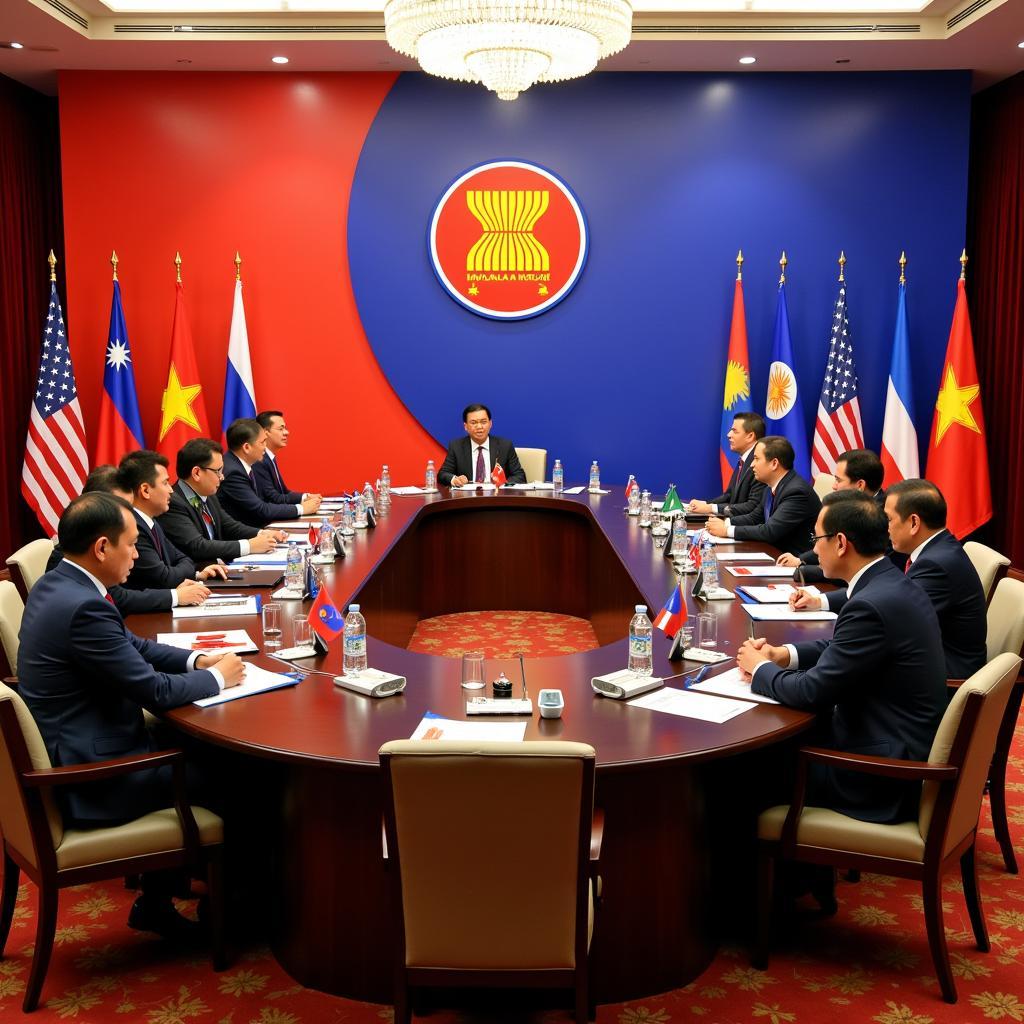The ASEAN Union, often referred to as ASEAN, stands as a testament to regional cooperation and integration in Southeast Asia. But what exactly is ASEAN, and how does it impact the lives of over 600 million people residing within its borders? This comprehensive guide delves into the intricacies of ASEAN, exploring its history, objectives, and significance on the global stage.
A Journey Through Time: The Genesis of ASEAN
 ASEAN Founding Fathers
ASEAN Founding Fathers
The seeds of ASEAN were sown in the mid-20th century, a time marked by the throes of decolonization and the emergence of independent nations in Southeast Asia. Five nations – Indonesia, Malaysia, the Philippines, Singapore, and Thailand – united by a shared vision of regional stability and prosperity, came together on August 8, 1967, to sign the ASEAN Declaration, also known as the Bangkok Declaration. This marked the formal establishment of the Association of Southeast Asian Nations (ASEAN).
Pillars of Progress: ASEAN’s Three-Pronged Approach
At the heart of ASEAN’s existence lies its commitment to fostering cooperation and integration among member states. This commitment is manifested through the pursuit of three fundamental pillars:
- ASEAN Political-Security Community (APSC): This pillar focuses on promoting peace, security, and stability in the region. It encompasses a wide range of activities, including conflict prevention, counter-terrorism, and maritime security cooperation.
- ASEAN Economic Community (AEC): Aiming to create a single market and production base, the AEC strives to enhance regional competitiveness, promote economic integration, and facilitate the free flow of goods, services, investments, and skilled labor within ASEAN.
- ASEAN Socio-Cultural Community (ASCC): Recognizing the importance of a people-oriented approach, the ASCC focuses on promoting human development, social justice, and environmental sustainability. It encompasses a broad spectrum of areas, including education, culture, health, and disaster management.
Expanding Horizons: ASEAN’s Dialogue Partners and Free Trade Agreements
ASEAN’s influence extends far beyond the borders of its member states. It actively engages with dialogue partners, including major global powers like the United States, China, Japan, and the European Union. These partnerships facilitate dialogue, cooperation, and economic ties between ASEAN and the rest of the world.
Furthermore, ASEAN has forged several free trade agreements (FTAs) with its dialogue partners, creating a network of preferential trade agreements that contribute to regional and global economic integration.
Navigating Challenges: ASEAN in the 21st Century
 ASEAN Summit
ASEAN Summit
The ASEAN Union, while a testament to regional cooperation, faces a myriad of challenges in the 21st century. Geopolitical tensions, economic disparities among member states, and the rise of non-traditional security threats like climate change and pandemics test the resilience of the organization.
However, ASEAN has consistently demonstrated its ability to adapt and evolve. It continues to play a pivotal role in fostering dialogue, building consensus, and promoting cooperation on regional and global issues.
A Vision for the Future: ASEAN Community Vision 2025
Looking ahead, ASEAN has outlined a roadmap for its future through the ASEAN Community Vision 2025. This vision aims to create a more integrated, resilient, and prosperous ASEAN Community that is people-centered, people-oriented, and rules-based.
Conclusion: ASEAN – A Beacon of Hope and Collaboration
The ASEAN Union stands as a beacon of hope and a testament to the power of regional cooperation. While challenges remain, ASEAN’s unwavering commitment to its founding principles, coupled with its proactive approach to addressing contemporary issues, positions it as a vital player on the global stage. As ASEAN continues to evolve and adapt, it holds the potential to shape a more peaceful, prosperous, and sustainable future for Southeast Asia and the world.
FAQs about ASEAN
1. What is the main purpose of ASEAN?
ASEAN’s primary goal is to accelerate economic growth, social progress, and cultural development among its member states. It aims to promote regional peace and stability through collaboration and dialogue.
2. How many countries are in ASEAN?
There are ten member states in ASEAN: Brunei, Cambodia, Indonesia, Laos, Malaysia, Myanmar, the Philippines, Singapore, Thailand, and Vietnam.
3. What are some of ASEAN’s achievements?
ASEAN has achieved significant milestones, including the establishment of the ASEAN Free Trade Area (AFTA), the signing of the ASEAN Charter, and the launch of the ASEAN Community Vision 2025.
4. How does ASEAN benefit its member states?
ASEAN membership provides numerous benefits, including enhanced economic opportunities, increased regional security, and a platform for addressing shared challenges.
5. What is the role of the ASEAN Secretariat?
The ASEAN Secretariat, based in Jakarta, Indonesia, serves as the administrative and coordinating body of ASEAN. It supports the implementation of ASEAN’s programs and initiatives.
For further information or assistance, please don’t hesitate to reach out to us. Our dedicated customer support team is available 24/7 to address your inquiries. Contact us at:
Phone Number: 0369020373
Email: aseanmediadirectory@gmail.com
Address: Thon Ngoc Lien, Hiep Hoa, Bac Giang, Vietnam
ase credit union greenville al
We’re here to help you navigate the diverse and dynamic world of ASEAN.


